(Cross-posted from Daily Kos)
As I promised in a previous diary, I would go into further detail about the predictions that I made above. My analysis is largely based off of the county-by-county breakdowns of the vote given at CNN, while any demographic data is from what I have found at the U.S. Census Bureau. I recognize that a lot of my predictions may be largely based on generalizations and historical observations, but I think that, for the most part, they will hold up.
For the first part of my series, I will start off chronicling my predicted results in Pennsylvania, the next state to hold a nominating contest (on April 22nd). Below the fold, find my district-by-district delegate projections…
Pennsylvania (April 22nd, 158 pledged delegates)
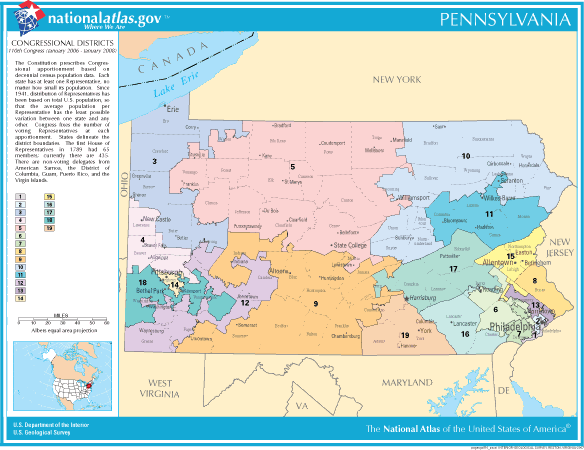
Much of what needs to be said about Pennsylvania doesn’t need to be repeated. In short, it’s a state whose demographics play well to Hillary Clinton’s prospects of winning the state. Aside from having Clinton’s family roots in Northeast PA, the Keystone State is one of the oldest states in the nation, one of the most Catholic, and one that has a lot of working-class white voters – all groups that have, with few exceptions, gone to Clinton. As has been noted in the past, Obama’s best chances at getting any sort of victory out of the state is to follow Ed Rendell’s recipe for victory in the heated 2002 Democratic primary contest against now-Sen. Bob Casey: rack up huge margins in southeast Pennsylvania, especially in Philadelphia and its surrounding suburbs. It’s probably the best strategy, but there are differences – notably that Rendell was widely-known in the area due to his 8-year tenure as mayor of Philadelphia.
Obama’s recent bus tour throughout the state, interestingly enough, focused on the areas that are expected to be solidly for Clinton. He spent a great deal of time in western and central PA, only visiting Philadelphia and its suburbs on the last day of his ‘Road to Change’ tour. In addition, the surprising endorsement by Senator Casey may help Obama win over the socially conservative Democrats that make up a good portion of the state’s Democratic voters – and helped give Casey and overwhelming victory over Rick Santorum in 2006. Nevertheless, I still think that Obama is fighting an uphill battle, as you’ll see in the congressional district breakdown.
PA CD-01: 7 delegates
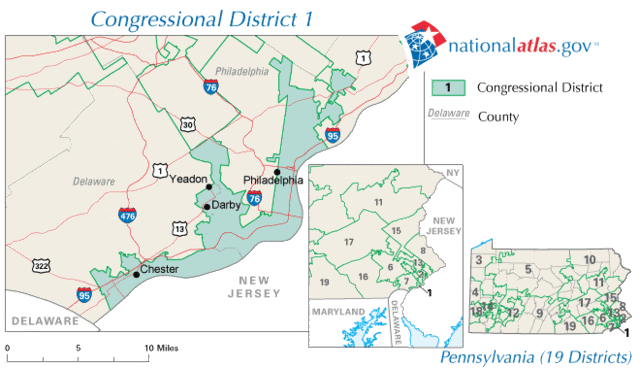
Pennsylvania’s 1st Congressional District is one of the four districts (the others being CD-02, CD-08, and CD-13) that represent a portion of Philadelphia in the House. Demographically, CD-01 has a plurality of African-Americans living in the district (45.7%), although it does include the ethnic European enclaves in Northeast Philadelphia that may not be as friendly territory for Obama. Its representative, Democrat Bob Brady, is the longtime chairman of the Philadelphia Democratic Party and is probably the most powerful of the ‘machine’ politicians in the city. He is currently undecided, but given the way the demographics of the district work out – coupled with Obama’s generally strong performance in urban cities – Obama will pick up 1 delegate in a 4-3 decision. Obama would need 64.3% of the vote to make it a 5-2 split – something that is unlikely to happen.
Allocation of CD-01 delegates
Barack Obama: 4 pledged delegates
Hillary Clinton: 3 pledged delegates
PA CD-02: 9 delegates
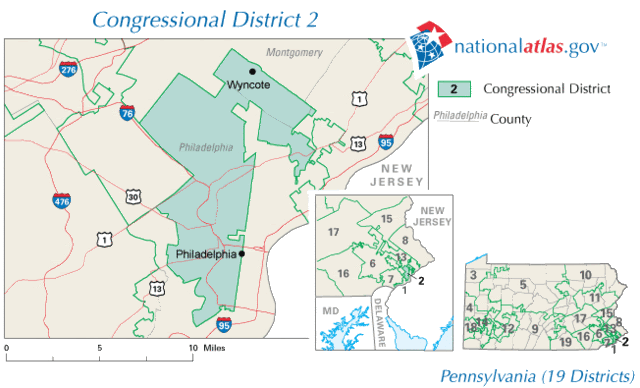
This is a district where Obama will dominate. Having called this district ‘home’ for a good portion of the past 4 years, Obama is going to perform excellently based on the ground game presence. Comprised of University City, West Philadelphia, and almost the rest of Philadelphia County, the district is majority African-American (61%), and its representative, Chaka Fattah, was an early endorser of Obama. Given the strong higher-education presence as well, and it’s a near-certainty that Obama will easily break the 61.11% threshold needed for a 6-3 delegate split. That being said, I don’t think he’ll be able to break the 72.22% barrier to earn a 7-2 split. It’s with the realm of possibility, though. I stopped in at Obama’s West Philadelphia satellite office yesterday, and one of the staffers felt that an 8-1 split was completely within reach. I’ll believe it when I see it.
Allocation of CD-02 delegates
Barack Obama: 6 pledged delegates
Hillary Clinton: 3 pledged delegates
PA CD-03: 5 delegates
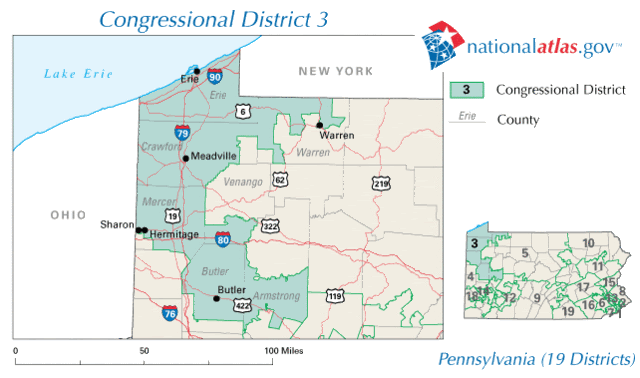
CD-03, represented by Republican Phil English, is a district that is going to likely be one where Clinton racks up huge margins. The counties in Eastern Ohio bordering this region routinely gave Clinton upwards of 65% of the vote. It is a mostly urbanized district, but cities such as Erie are old industrial towns with a lot of the working-class white voters where Clinton has done well. Bill Clinton has already paid a visit to Erie; Obama has yet to make a visit to this area of western PA. With a very small African-American population (3.4%), I think that the Clinton campaign will give enough focus to this district to pull out a 4-1 delegate split – meaning that she will put in over 70% of the vote.
Allocation of CD-03 delegates
Hillary Clinton: 4 pledged delegates
Barack Obama: 1 pledged delegate
PA CD-04: 5 delegates

CD-04 is represented by freshman Democrat Rep. Jason Altmire, who has seemingly leaned towards Obama despite remaining officially neutral. However, the district, which encompasses some of the Pittsburgh suburbs, is likely to vote for Clinton in huge margins. It borders the same eastern Ohio counties that gave her big victories, although they went for even larger margins for Clinton than did the counties bordering CD-03. It’s one of the ‘Pennsyltucky’ districts that have not treated Obama kindly in the past. While he did spend some time in the first days of his bus tour, I don’t think Obama will be able to break 30% and hold Clinton to a 3-2 margin.
Allocation of CD-04 delegates
Hillary Clinton: 4 pledged delegates
Barack Obama: 1 pledged delegate
PA CD-05: 4 delegates
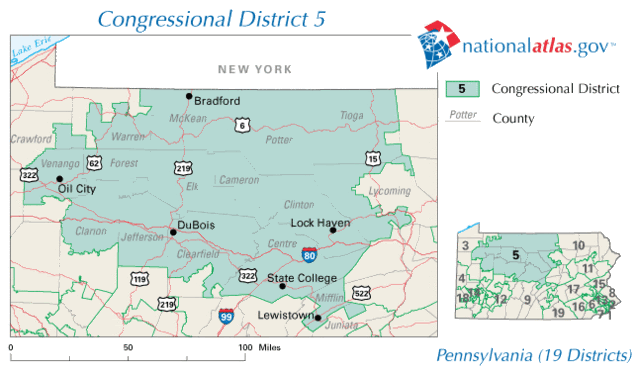
On first glance; this would seem to be a clear 3-1 district for Clinton (which requires 62.5% of the vote): the counties in New York bordering CD-05 went to Clinton by over that amount of the vote. However, it also includes State College (home to Penn State), which, if Obama’s record-breaking appearance is any indication, he will be able to rack up a solid number of votes there – and be able to hold Clinton below the 62.5% threshold.
Allocation of CD-05 delegates
Hillary Clinton: 2 pledged delegates
Barack Obama: 2 pledged delegates
PA CD-06: 6 delegates
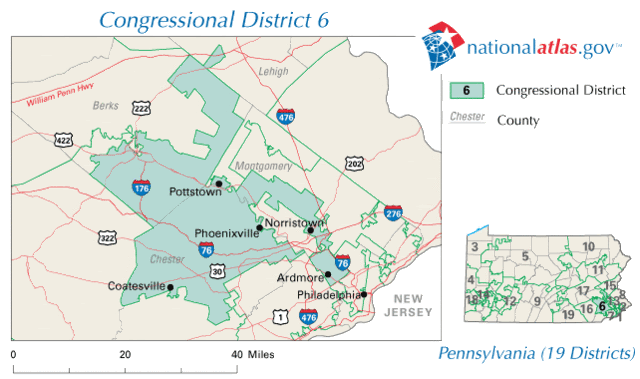
Of the 3 suburban Philadelphia districts that the Democrats targeted in 2006, this is the only one to have stayed in Republican hands despite its increasingly Democratic lean. While the district is predominantly white, it also has a median income above the state average – indicating it may contain the higher-educated white voters that tend to vote for Obama. Given its historical Republican bent, though, the Obama campaign needs to ensure that its voter registration drive was able to pick up enough of these new Democratic voters. There doesn’t seem to be any indication that either candidate will break the 58.5% threshold to earn a 4-2 split, so we’ll call this one even.
Allocation of CD-06 delegates
Hillary Clinton: 3 pledged delegates
Barack Obama: 3 pledged delegates
PA CD-07: 7 delegates

PA-07 is now represented by Democrat Joe Sestak after 20 years in GOP hands. As another wealthy, white district whose voters have become increasingly liberal over the years, this represents a good opportunity for Obama to net a delegate out – so long as enough voters flipped their registration to Democratic. Although Sestak himself is a Clinton supporter – and served in Bill Clinton’s White House – I still believe Obama will win the majority of delegates.
Allocation of CD-07 delegates
Barack Obama: 4 pledged delegates
Hillary Clinton: 3 pledged delegates
PA CD-08: 7 delegates
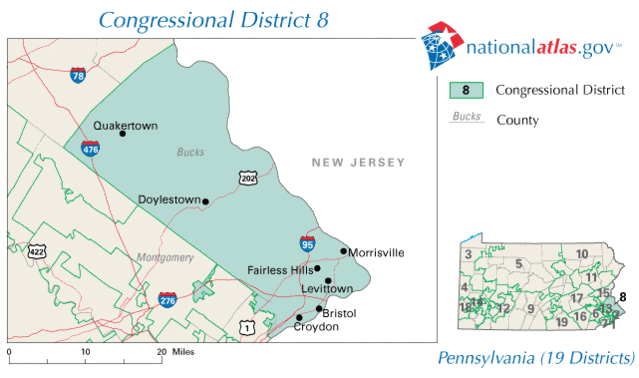
The last of the suburban Philadelphia districts, represented by Obama backer and Iraqi war veteran Patrick Murphy, also looks to be good for Obama. Again, Obama’s performance will likely depend upon the number of voters that re-registered as Democrats; Bucks County, which makes up the vast majority of the district (it also includes a sliver of Montgomery County and Northeast Philadelphia), had a registered GOP majority until recently – even though the district has gone to both Al Gore and John Kerry in the past two presidential elections. It also has the highest median income of PA-06, PA-07, and PA-08, which likely bodes well for Obama given how primary season has played out. Ultimately, Obama will likely net the extra delegate from this district, particularly when aided by Murphy’s excellent field operation in the district.
Allocation of CD-08 delegates
Barack Obama: 4 pledged delegates
Hillary Clinton: 3 pledged delegates
PA CD-09: 3 delegates
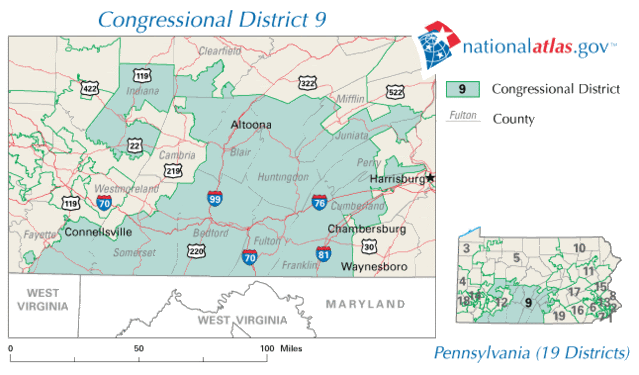
In a sense, Obama is lucky that this district only has 3 delegates: it’s a rural white, working-class district where he will likely perform quite poorly. It does contain Altoona, site of Obama’s now-infamous bowling outing, which garnered him good local press. However, the counties in Maryland that border the district went to Clinton by wide margins. It’ll be an easy 2-1 split in her favor.
Allocation of CD-09 delegates
Hillary Clinton: 2 pledged delegates
Barack Obama: 1 pledged delegate
PA CD-10: 4 delegates

This is another district where Obama is lucky that there are not too many delegates. A mostly rural district in Northeast PA that borders New York to the North and encompasses a good portion of the Scranton/Wilkes-Barre area (without the cities themselves), this should be solid Clinton territory in terms of the popular vote. In the counties bordering New York, Clinton came close to – but didn’t break – the 62.5% barrier that will be needed to net an extra delegate from this district. While it’s possible, given her ties to the region, that she’ll do so, I think that Obama will perform well enough to hold Clinton to a 2-2 split. This is also a district where Casey’s endorsement may very well help (Northeast PA is Casey’s base).
Allocation of CD-10 delegates
Hillary Clinton: 2 pledged delegates
Barack Obama: 2 pledged delegates
PA CD-11: 5 delegates
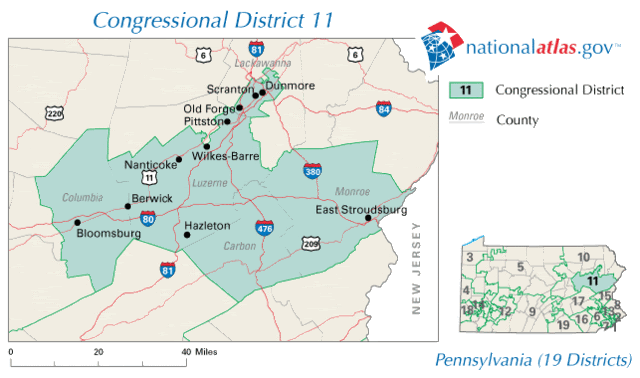
Hillary Clinton’s father and his relatives come from the Scranton area, which is encompassed by this district. It won’t come as any shocker that Clinton takes the extra delegate from this district; it’s a matter of if she can manage to make a run at the 70% barrier to get a 4-1 split. While the demographics (white working-class Catholics) is largely favorable towards her, this may be another district where Casey’s endorsement may help Obama limit the damage. Furthermore, the neighboring counties in NJ were not favorable to Clinton to the point where she was getting 70% of the vote. A 3-2 split is the likely outcome.
Allocation of CD-11 delegates
Hillary Clinton: 3 pledged delegates
Barack Obama: 2 pledged delegates
PA CD-12: 5 delegates
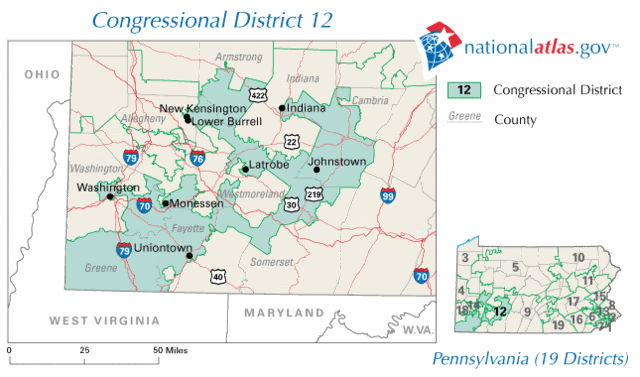
This heavily-gerrymandered district is represented by Clinton backer Rep. John Murtha. This is another ‘Pennsyltucky’ district where Clinton should be able to attain the 70% necessary to earn a 4-1 delegate split. It’s a white, working-class district that was a part of Pennsylvania’s industrial heyday. While Obama did come through the region on his bus tour, holding a townhall in Johnstown and stopping in Latrobe for a meal, his campaign’s main goal should be to try and ensure that they can somehow break 30% and keep the split to 3-2. I don’t think it will happen.
Allocation of CD-12 delegates
Hillary Clinton: 4 pledged delegates
Barack Obama: 1 pledged delegate
PA CD-13: 7 delegates
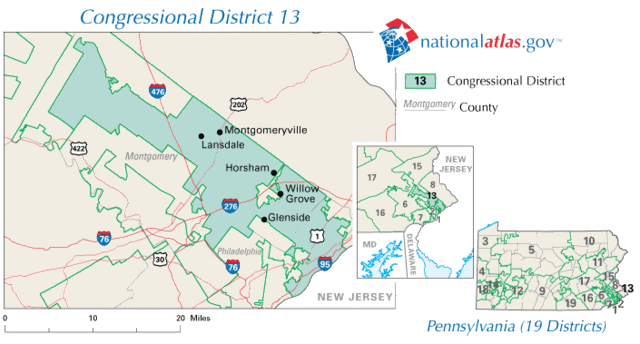
District 13 used to be a heavily-contested swing district held previously by Joe Hoeffel, but since Allyson Schwartz (a Clinton backer) won the seat in 2004 with relative ease, it has become a safe Democratic seat. Encompassing parts of Northeast Philadelphia and portions of Montgomery County, it’s a bit more working-class than the other, more affluent suburban Philadelphia districts. In this case, I believe that Clinton has the advantage in this district and will be able to win a majority of the votes.
Allocation of CD-13 delegates
Hillary Clinton: 4 pledged delegates
Barack Obama: 3 pledged delegates
PA CD-14: 7 delegates
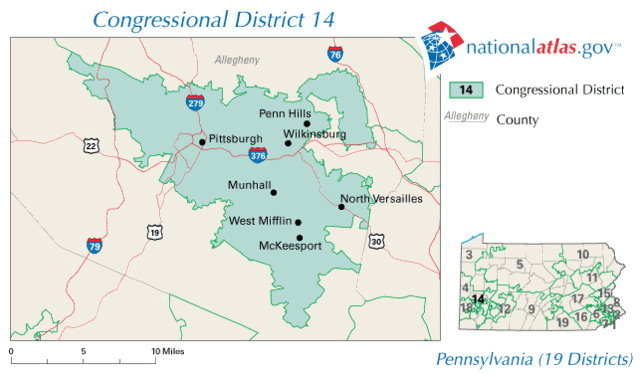
District 14 includes the big city of Pennsylvania, Pittsburgh. While it is in the western part of the state – an area that will perform well for Clinton – it has a sizable African-American population (about 22.4%) and should allow Obama to keep Clinton’s margin of victory to 1. It still has a great number of the working-class whites that have gone for Clinton, and the median income in the district is below the average for the state. While Pittsburgh does have more of a service-based economy now, I still believe Clinton will win the district.
Allocation of CD-14 delegates
Hillary Clinton: 4 pledged delegates
Barack Obama: 3 pledged delegates
PA CD-15: 5 delegates
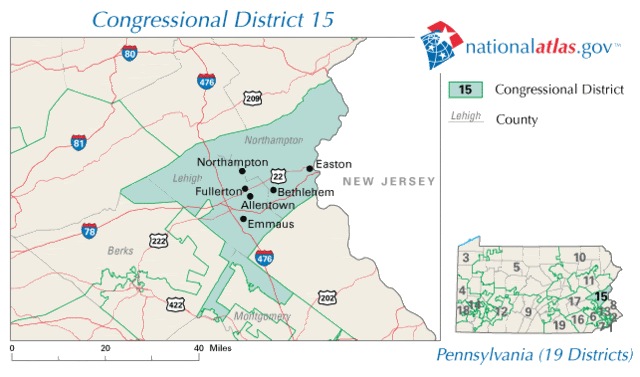
District 15 is part of Lehigh Valley – an area where Obama will need to perform strongly if he is to have a chance of closing the margin. It includes the old steel city of Allentown, and the demographics should be favorable to Clinton – a generally middle-class district with lots of white Catholics. In New Jersey, though, Clinton only won the neighboring counties with vote percentages in the mid-50s. With a 70% split required to get a 4-1 split, a 3-2 margin in favor of Clinton is the likeliest result. Look for a potential upset if Obama’s presence in the area’s colleges is able to overcome his disadvantages in the district.
Allocation of CD-15 delegates
Hillary Clinton: 3 pledged delegates
Barack Obama: 2 pledged delegates
PA CD-16: 4 delegates

This district includes Lancaster County and is characterized by a mostly suburban makeup, with a few cities here and there. Neither candidate has such a decided advantage that the delegate split will likely be anything other than a solid 2-2 allocation.
Allocation of CD-16 delegates
Hillary Clinton: 2 pledged delegates
Barack Obama: 2 pledged delegates
PA CD-17: 4 delegates

District 17 is in south-central PA; it includes the state capital of Harrisburg, along with other small cities such as Hershey and Reading. While it is demographically favorable towards Clinton, Obama will likely be able to win more than enough support to keep the delegate split even in the district. While there are definitely racial undertones to the vote in this part of the state, I think Obama can earn 37.5% of the vote easily enough.
Allocation of CD-17 delegates
Hillary Clinton: 2 pledged delegates
Barack Obama: 2 pledged delegates
PA CD-18: 5 delegates
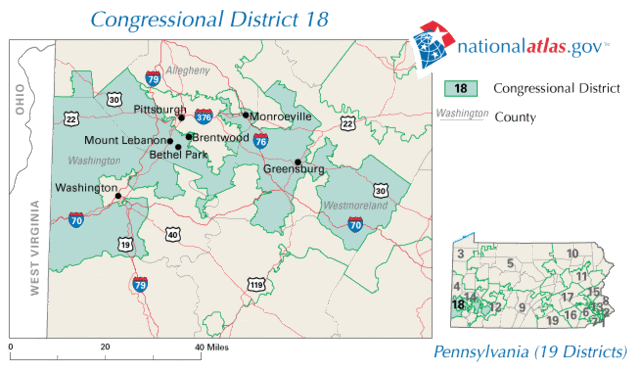
This is the last of the ‘Pennsyltucky’ districts in the state; sharing a border with a sliver of West Virginia (which then borders Eastern Ohio, a part of the state where Clinton performed extremely well), Clinton is likely to perform well here as well. While she needs 70% of the vote to take a 4-1 split, I am inclined to believe that it’s likely to happen. While it does include some of the Pittsburgh suburbs, these are likely to be solidly Clinton as well. With an extremely small African-American population and a solidly working-class base, Clinton looks to outperform in this district.
Allocation of CD-18 delegates
Hillary Clinton: 4 pledged delegates
Barack Obama: 1 pledged delegate
PA CD-19: 4 delegates
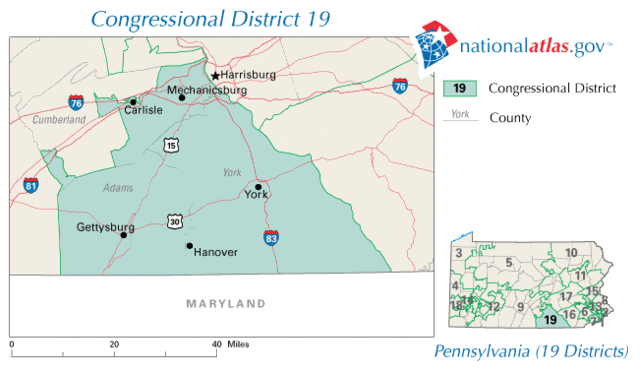
District 19 is in south-central PA and borders Maryland counties where Obama performed well. While the demographics favor Clinton (middle-class white votes), I don’t anticipate either side performing well enough to earn the 3-1 delegate split – at least from what I can tell. There aren’t any indications that lead me to believe that Clinton will be able to get over the 62.5% threshold, but it’s possible.
Allocation of CD-19 delegates
Hillary Clinton: 2 pledged delegates
Barack Obama: 2 pledged delegates
At-Large Delegates (35 delegates) and Pledged PLEO Delegates (20 delegates)
My current estimate is that PA will end up much like Ohio: Clinton will score a win in the low double digits. My estimates (which are conservative for Obama, I will admit) have Clinton winning the state 56%-44%. This would lead to Clinton netting +7 delegates at the statewide level. If I do a popular vote percentage based on the current RealClearPolitics polling average, Clinton wins 54%-46% and wins the at-large delegates 19-16 instead of 20-15, as I currently estimate.
Allocation of at-large delegates
Hillary Clinton: 20 pledged delegates
Barack Obama: 15 pledged delegatesAllocation of pledged PLEO delegates
Hillary Clinton: 11 pledged delegates
Barack Obama: 9 pledged delegates
Conclusion
In closing my current prediction is that Hillary Clinton will win 88 pledged delegates, compared to 70 pledged delegates for Barack Obama. This would lead to a net pickup of 18 delegates for Clinton, leaving her 151 pledged delegates behind Obama (according to his website’s delegate counter). It would be a solid enough victory from the Clinton campaign’s perspective to continue on the primary fight until the Indiana and North Carolina nominating battles two weeks later, on May 6th. That being said, there is still room for Obama to perform better (or worse) than I have stated above.
Best-case scenario for Obama
I don’t believe Obama will win the popular vote outright in the state (which would effectively end Clinton’s campaign on April 22nd). That being said, he can drastically narrow Clinton’s delegate pickup if he can hold her below 70% in districts 3, 4, 12, and 18. Combined with outperforming in districts 1 (earning over 64.3% of the vote) and in district 2 (if Obama can surpass 72.22% of the vote to earn a 7-2 split). If he loses the popular vote by 6% (53-47), this will result in Clinton merely netting 4 delegates from the state (81-77). This ‘victory’ for Clinton would effectively be a hollow one, and the calls for her to step out of the race would increase greatly. If the vote % was even narrower (52-48, for example), Clinton’s delegate lead disappears completely, leading to a 79-79 delegate split.
Worst-case scenario for Obama
While my initial estimate for Obama was already fairly conservative, I believe that he could perform worse if things don’t break his way. I don’t think that the popular vote margin he will lose by will be greater than 15%, so I put the worst-case as 58-42 Clinton (she picks up another pledged PLEO). Furthermore, she outperforms in northern PA (winning 3-1 in districts 5 and 10, and 4-1 in Scranton’s district 11) and in the Philadelphia suburbs, where she earns the 4-3 margin instead of Obama. Lastly, she picks up a 3-1 split in southern PA, in district 19. These results lead to a 95-63 delegate split in her favor, which would cut down Obama’s pledged delegate lead to 137. While it’s still sizable, Obama’s best chance at making sure the campaign doesn’t go to the convention is to ensure his margin is greater than the amount that could be earned by Clinton if Florida and Michigan are seated as is (which is highly unlikely to begin with). This would be a large victory for Clinton and would embolden her campaign to continue along the largely negative track that it’s followed for some time.
In conclusion, it’s extremely difficult to expect Obama to pick up a victory in Pennsylvania. A popular-vote win would end the campaign immediately, but even if he comes within a few percentage points, he will be able to effectively hold Clinton’s delegate gains to the low single digits – while taking the largest prize remaining off the table. The key to his ‘victory’, so to speak, is to run up the margins in Philadelphia while keeping his losses in Western PA to a minimum. For Clinton, it’s imperative for her to outperform in the ‘Pennsyltucky’ districts and in northeast PA – while running up the statewide popular vote tally.



Great analysis. People tend to forge that all politics is local…
Fixed.
Wow.
A couple of comments:
I’ve lived all my longish life in various parts of Pennsylvania, and this is the first year I’ve heard anything at all about Hillary Clinton’s deep roots here. I’m not disputing them; I’m just surprised I never heard about them.
I live in District 19 now. Petitions always need to be signed in February, when it’s miserable going door to door, so locally we’ve been throwing petition-signing parties: All registered Democrats are encouraged to stop by, sign petitions, and have some free pizza. Our county chair, who is running for Clinton delegate, was to be present, and I figured I’d be among the lonely few signing the Obama petitions. But at the end of the night, dozens of pizzas later, the Obama petitions had considerably more signatures than the Clinton petitions. No, I can’t explain it either–it was our local crowd that we see at our annual picnic and at the polls and not a sudden influx of Obama youth–but there’s something going on here at the grassroots.
Cruising through these maps, it is striking how bizarre the shapes are for some of the districts. Six, twelve and eighteen stand out. Gerrymandering, I presume. But perhaps there is some logic based on geography (rivers, old rr communities, etc.). Could anyone comment on that?
I live in -06. Sad to say, the basis for it’s odd shape was to make it a safe seat for Gerlach…nothing geographic about it.
Yes, the Republican legislature took the Texans as a role model in gerrymandering.
For example, 17, which looks pretty regular, was set up with as many Rs and as few Ds as possible to give (R) Gekas an easy win against (D) Holden. Instead, the popular ex-sheriff Holden from a somewhat Republican district won in the new, much more R 17th.
“In conclusion, it’s extremely difficult to expect Obama to pick up a victory in Pennsylvania. A popular-vote win would end the campaign immediately, but even if he comes within a few percentage points, he will be able to effectively hold Clinton’s delegate gains to the low single digits..“
Well, he may surprise. Indeed.
Last week Polls showed Obama closing the gap.
And Obama had a good weekend. Picked up add-ons and super Ds
Well, sure, if you want to count the delegates that way. But if we only count white people — and really it’s just the racist ones who count — in Appalachia, Hillary’s going to net 600 delegates by rewriting the count for Penn at the DNC, and it’ll all be over.